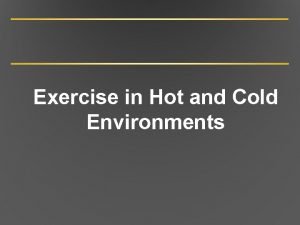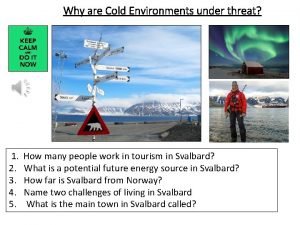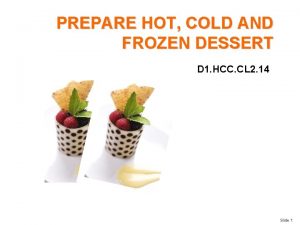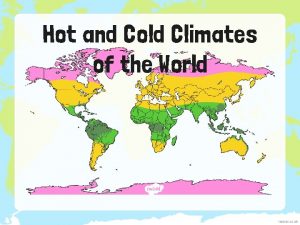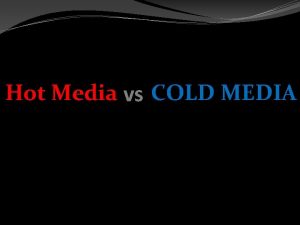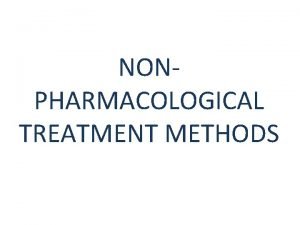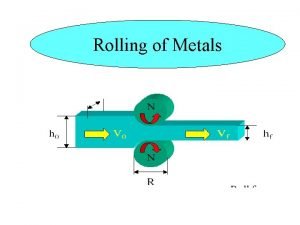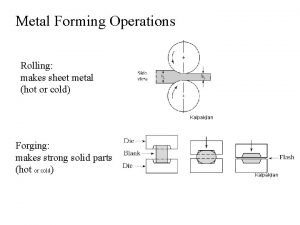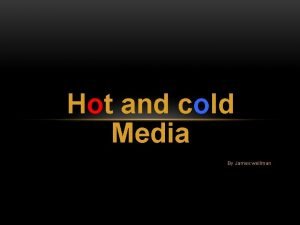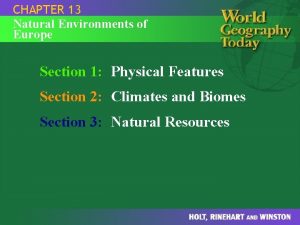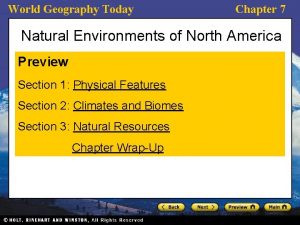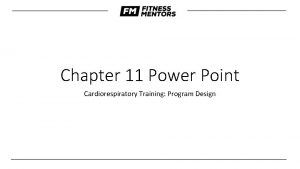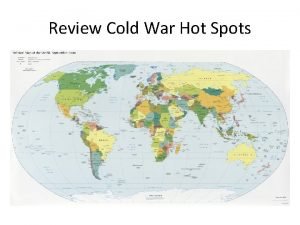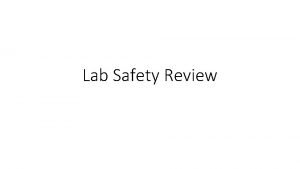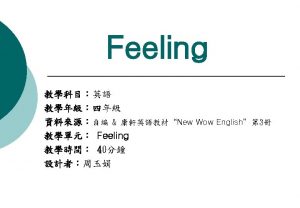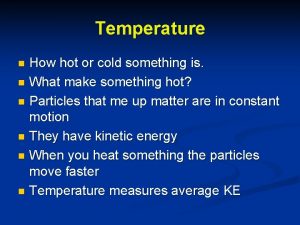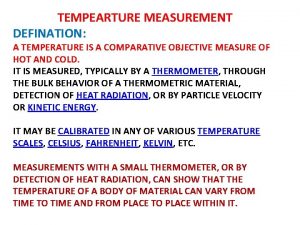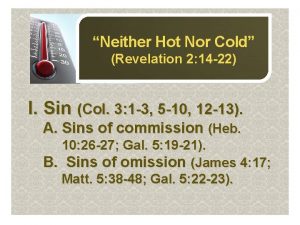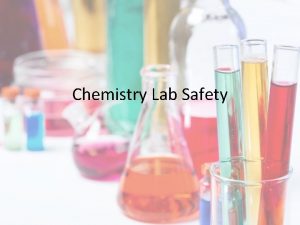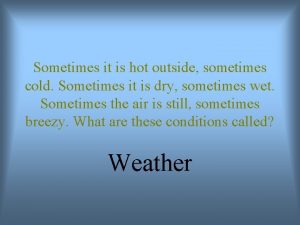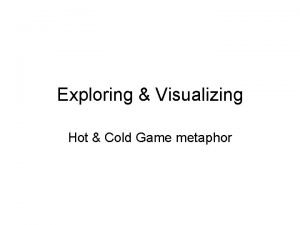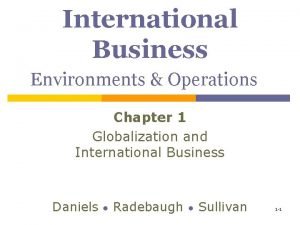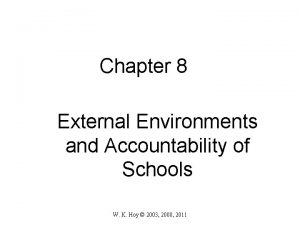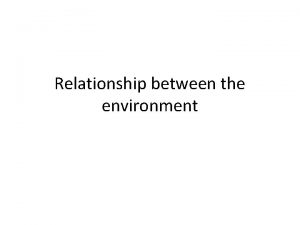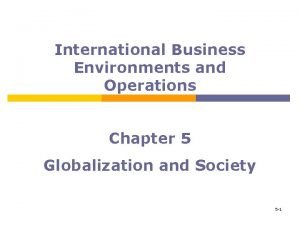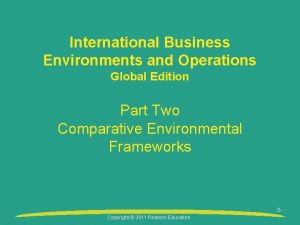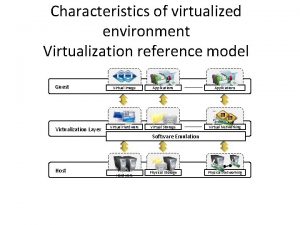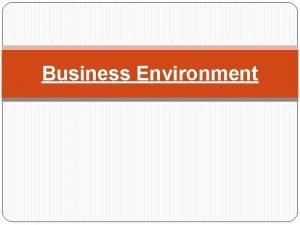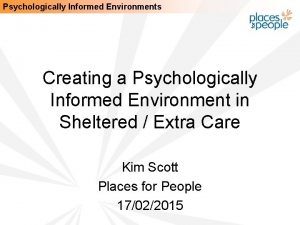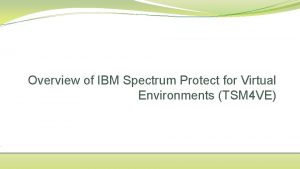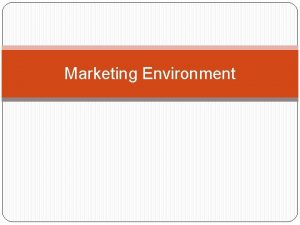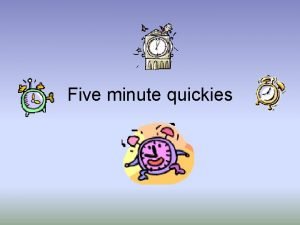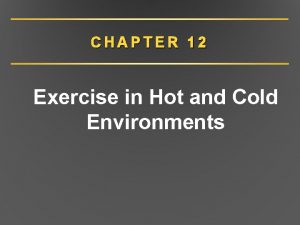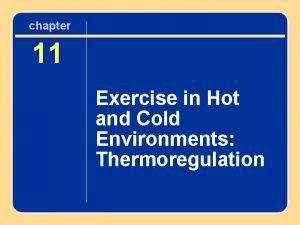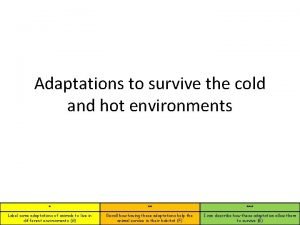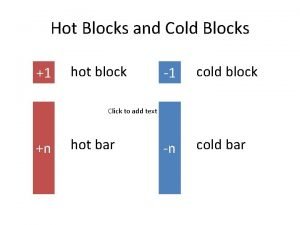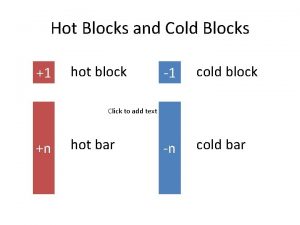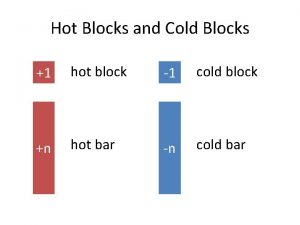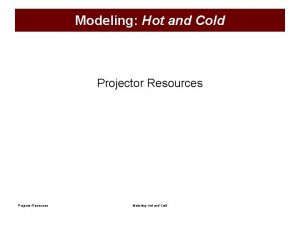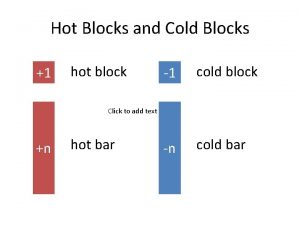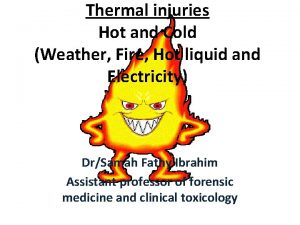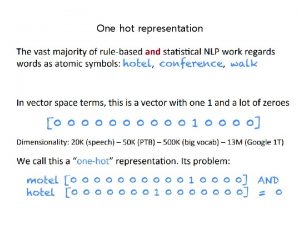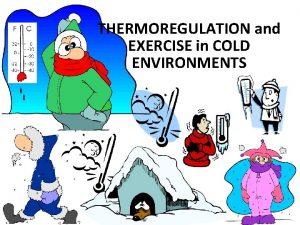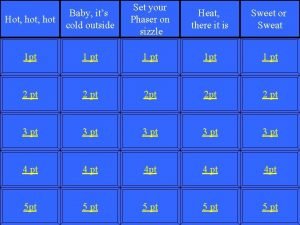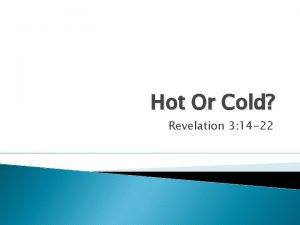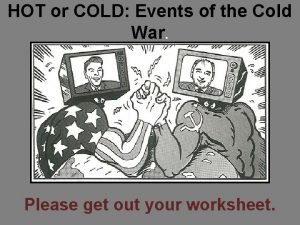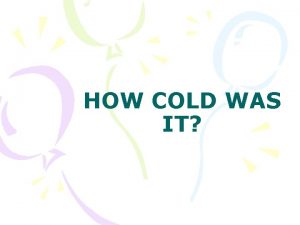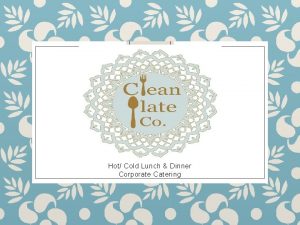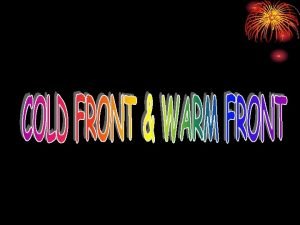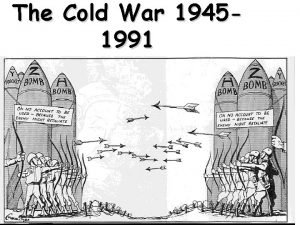CHAPTER 12 Exercise in Hot and Cold Environments



























































- Slides: 59

CHAPTER 12 Exercise in Hot and Cold Environments

CHAPTER 12 Overview • Body temperature regulation • Exercise in heat – Physiological responses – Health risks – Acclimation • Exercise in cold – Physiological responses – Adaptations – Health risks

Body Temperature Regulation • Stress of physical exertion complicated by environmental thermal conditions • Humans are homeothermic – Internal body temperature regulated, nearly constant despite environmental temperature changes – Thermoregulation: regulation of body temperature around a physiological set point

Body Temperature Regulation • Acclimation: short-term adaptation to environmental stressor (days/weeks) • Acclimatization: long-term adaptation to environmental stressor (months/years) • Conversion equations – C° = (F° – 32) / 1. 8 – F° = (C° x 1. 8) + 32

Body Temperature Regulation: Metabolic Heat Production • Metabolic heat production (M) – <25% ATP breakdown cellular work (W) – >75% ATP breakdown metabolic heat • Transfer of heat between body and environment – Heat moves from body core to body shell via blood – When heat reaches skin, can be dissipated by conduction, convection, radiation, or evaporation

Figure 12. 1

Body Temperature Regulation: Transfer of Body Heat • Conduction (K) – Heat transfer from one solid material to another through direct molecular contact (negligible) – Sitting on chilly (or hot) metal bleachers • Convection (C) – Heat transfer by movement of gas or liquid across a surface – Movement across skin surface heat exchange – Major daily thermoregulatory factor

Body Temperature Regulation: Transfer of Body Heat • Radiation (R) – Heat loss in form of infrared rays – Body can give off or receive radiant heat – Major daily thermoregulatory factor • C + K + R = avenues of dry heat exchange – Insulation (I): resistance to dry heat exchange – Still layer of air ideal insulator

Figure 12. 3 a

Figure 12. 3 b

Body Temperature Regulation: Transfer of Body Heat • Evaporation (E) – Heat loss via phase change from liquid to gas – Primary heat loss during exercise (~80%) – Clothing = resistance to E • Heat balance equation – M – W ± R ± C ± K – E = 0 heat balance – If M – W ± R ± C ± K – E < 0 heat loss – If M – W ± R ± C ± K – E > 0 heat gain

Body Temperature Regulation: Transfer of Body Heat • Humidity and heat loss – Water vapor pressure (humidity) affects E – Humidity E, humidity E – Prolonged evaporation via sweat dehydration • Cooling capacity of sweat – Air temperature can become ≥ skin temperature – C will not work, must depend on E – 1. 5 L sweat evaporated cools 400 W

Figure 12. 4

Body Temperature Regulation: Thermoregulatory Control • If C and E unlimited, can withstand 200 °C • Briefly withstand core temperatures <35 °C, >41 °C • For normal ranges of body and air temperature, thermoregulatory responses very effective – Core temperature regulated around 37 °C – Core temperature >40 °C inhibits physiological function – Thermoregulatory function controlled by POAH

Body Temperature Regulation: Thermoregulatory Control • Preoptic-anterior hypothalamus (POAH) – Body’s thermostat located in the brain – Receives input from sensory thermoreceptors – When body temperature deviates, POAH activates thermoregulatory mechanisms • Sensory receptors – Peripheral thermoreceptors in skin – Central thermoreceptors in brain, spinal cord

Figure 12. 5

Body Temperature Regulation: Thermoregulatory Control • POAH signals sympathetic nervous system (SNS) effectors • Skin arteriole effectors – SNS vasoconstriction (VC) minimizes heat loss – SNS vasodilation (VD) enhances heat loss • Eccrine sweat gland effectors – SNS stimulation of sweating E heat loss – Acetylcholine: sympathetic cholinergic stimulation – More responsive to changes in core temperature than skin temperature

Body Temperature Regulation: Thermoregulatory Control • Skeletal muscle effectors – Help generate additional heat via shivering – Involuntary cycle of contraction and relaxation – Only heat production, no useful work • Endocrine gland effectors – Metabolism heat production – Cooling release of thyroxine, catecholamines – Hormonal stimulation of heat production

Physiological Responses to Exercise in the Heat • Exercise M heat load, disturbs thermal homeostasis in most environments • Effects on cardiovascular function – Skin arterioles VD to C heat loss, requires blood flow compared to exercise in the cold – POAH triggers SNS: cardiac output further via HR/contractility, VC to nonessential tissues – Blood volume (sweat), SV can’t (blood pooling), so HR further to compensate (cardiovascular drift)

Physiological Responses to Exercise in the Heat • Limitation: cardiovascular system overload – Heart cannot provide sufficient blood flow to both exercising muscle and skin – Impaired performance, risk of overheating – Especially in untrained or nonacclimated athletes • Limitation: critical temperature theory – Brain shuts down exercise at ~40 to 41 °C – Helps to explain limitations in trained, wellacclimated athletes

Figure 12. 6 a

Figure 12. 6 b

Figure 12. 6 c

Figure 12. 6 d

Physiological Responses to Exercise in the Heat: Fluid Balance • Sweating – Hot environmental temperatures > skin, core temperatures – C, K, R heat gain, E only avenue of heat loss – Eccrine sweat glands controlled by POAH • Sweat electrolyte content < plasma – Duct reabsorbs some Na+, Cl– Light sweating: very dilute sweat – Heavy sweating: less dilute (more Na+, Cl- loss)

Figure 12. 7

Physiological Responses to Exercise in the Heat: Fluid Balance • Training affects sweat composition – More sensitive to aldosterone – Reabsorb (i. e. , conserve) more Na+, Cl– K+, Ca 2+, Mg 2+ losses unchanged • Sweat losses during exercise – Can lose 1. 6 to 2. 0 L (2. 5 -3. 2% body weight) each hour – Sweating blood volume cardiac output – Severe dehydration onset of heat-related illness

Table 12. 1

Physiological Responses to Exercise in the Heat: Fluid Balance • Exercise and body water loss stimulate adrenal cortex and posterior pituitary gland • Hormonal control of fluid balance – Loss of water, electrolytes triggers release of aldosterone and antidiuretic hormone (ADH) – Aldosterone: retains Na+ at kidneys – ADH (vasopressin): retains water at kidneys

Health Risks During Exercise in the Heat • Six risk factors must be considered – – – Metabolic heat production Air temperature Ambient water vapor pressure (humidity) Air velocity Radiant heat sources Clothing • All factors influence degree of heat stress

Health Risks During Exercise in the Heat • Measuring external heat stress – Heat index does not reflect physiological stress – Wet-bulb globe temperature (WBGT) includes C, E, R • WBGT equation (gauge of thermal stress) – – Dry-bulb T: actual air temperature (i. e. , C) Wet-bulb T: reflects evaporative potential (i. e. , E) Globe T: measures radiant heat load (i. e. , R) WBGT = 0. 1 Tdb + 0. 7 Twb + 0. 2 Tg

Figure 12. 8

Health Risks: Heat Cramps • Least serious of three heat illnesses • Severe, painful cramping of large muscles • Triggered by Na+ losses, dehydration • Most common in heavy sweaters • Prevented by liberal Na+, water intake

Health Risks: Heat Exhaustion • Accompanied by fatigue; dizziness; nausea; vomiting; fainting; weak, rapid pulse • Caused by severe dehydration from sweating • Simultaneous blood flow needs of muscle and skin not met due to low blood volume • Thermoregulatory mechanisms functional but overwhelmed

Health Risks: Heatstroke • Life threatening, most dangerous • Thermoregulatory mechanism failure • Characterized by – Core temp >40 °C – Confusion, disorientation, unconsciousness • If untreated, results in coma and death • Must cool whole body ASAP (e. g. , ice bath)

Figure 12. 9

Health Risks: Preventing Hyperthermia • No outdoor activities when WBGT >28 °C • Schedule practice early morning or evening • Never restrict fluid intake – Fluids readily available to replace sweat losses – Drink breaks every 15 to 30 min – Minimizes rise in HR, core temperature • Minimize clothing (especially football players)

Figure 12. 10

Health Risks: Guidelines for Practicing and Competing in Heat • Events should not take place during hottest time of day, avoid WBGT >28 °C • Adequate supply of palatable fluids • Customize fluid intake based on fluid losses (1 L sweat loss = 1 kg weight loss) • Be aware of signs of heat illness • Organizers get final call on stopping events, excluding athletes who have heat illness

Acclimation to Exercise in the Heat • Repeated exercise in heat rapid changes for better performance in hot conditions – Acclimation: short term (9 -14 days) – Acclimatization: long term (months/years) • Effects of acclimation – Cardiovascular function optimized – Sweating rate, sweat distribution, and sweat content change – Results in a lower core temperature during exercise

Acclimation to Exercise in the Heat • Plasma volume due to oncotic P – Temporary (back to normal after 10 days) – Buys time for other adaptations to occur • Heart rate, cardiac output – Supports skin blood flow – Greater heat loss, core temperature • Widespread sweating earlier, more dilute – Prevents dangerous Na+ loss – Optimized E heat loss

Figure 12. 11

Figure 12. 12 a

Figure 12. 12 b

Figure 12. 12 c

Exercise in the Cold • Cold stress: any environmental condition causing loss of body heat • Core or skin temperature triggers physiological + behavioral mechanisms – – POAH triggers peripheral VC POAH triggers nonshivering thermogenesis POAH triggers skeletal muscle shivering Cerebral cortex triggers behavioral adaptations

Figure 12. 13

Exercise in the Cold • Cold habituation – Occurs after repeated cold exposures without significant heat loss – VC, shivering blunted; core temperature allowed to more • Metabolic acclimation – Occurs after repeated cold exposures with heat loss – Enhanced metabolic, shivering heat production • Insulative acclimation – When metabolism cannot prevent heat loss – Enhanced skin VC ( peripheral tissue insulation)

Exercise in the Cold • Dangerous (hypothermia-inducing) environmental conditions hard to define • Body composition affects heat loss – Inactive peripheral muscle = insulation – Subcutaneous fat = insulation – Body surface area: mass ratio = heat loss – Child versus adult versus elderly – Men versus women

Table 12. 2

Exercise in the Cold • As with heat, air temperature alone not a valid index of heat loss • Windchill affects heat loss – Often misunderstood: air movement, not air temperature – Index based on cooling effect of wind – Increases C heat loss – Refers to cooling power of environment – Windchill = risk of freezing tissues

Figure 12. 14

Exercise in the Cold • Water has thermal conductivity 26 times greater than air • Cold water versus air affects heat loss – When C + K + E + R is considered, heat loss 4 times faster in cold water versus cold air – Core temperature constant until water temp <32 °C – Core temperature 2. 1 °C/h in 15 °C water – Heat loss in moving water, with exercise – Hypothermia from cold water occurs well above 0 °C

Physiological Responses to Exercise in the Cold • Muscle function – Altered fiber recruitment contractile force – Shortening velocity and power – Affects superficial muscles (deep muscle spared) • As fatigue , metabolic heat production – Energy reserve depletion with endurance exercise potential for hypothermia

Physiological Responses to Exercise in the Cold • FFA metabolic responses – Normally, catecholamines FFA oxidation – Cold catecholamine secretion but no FFA – VC in subcutaneous fat FFA mobilization • Glucose metabolic responses – Blood glucose maintained well during cold exposure – Muscle glycogen utilization – Hypoglycemia suppresses shivering

Health Risks During Exercise in the Cold • Hypothermia – Core temp 34. 5 to 29. 5 °C: POAH function compromised – Core temp <29. 5 °C: POAH thermoregulation completely lost, metabolism slows, drowsiness, lethargy, coma • Cardiorespiratory effects of cold – Low core temperature slow HR (SA node effects) – Cold air does not damage ventilatory tissues – Cold may ventilation (rate and volume)

Figure 12. 15

Health Risks During Exercise in the Cold • Treatment for mild hypothermia – Remove individual from cold – Provide dry clothing, blankets, warm beverages • Treatment for severe hypothermia – Gentle handling to avoid arrhythmias – Gradual rewarming – May require hospital facilities, medical care

Health Risks During Exercise in the Cold • Frostbite – – Peripheral tissue freezing (air temperature ~− 29 °C) Excess VC lack of O 2, nutrients tissue death Untreated frostbite gangrene, tissue loss Gradually rewarm only when no risk of refreezing • Exercise-induced asthma – Affects up to 50% of winter-sport athletes – Excessive airway drying – Treated with b-agonists, steroid inhalers
 Exercise in hot and cold environments
Exercise in hot and cold environments Economic activity
Economic activity Difference between spread and filling
Difference between spread and filling He prepares all hot and cold dessert
He prepares all hot and cold dessert Media hot and cold
Media hot and cold Hot and cold climates
Hot and cold climates Hot working and cold working difference
Hot working and cold working difference Hot working diagram
Hot working diagram Hot media and cold media
Hot media and cold media Machining operations
Machining operations Contoh hot working
Contoh hot working Hot and cold application
Hot and cold application Hot cold media
Hot cold media Examples of hot sandwiches
Examples of hot sandwiches Flat rolling
Flat rolling Hot rolling and cold rolling
Hot rolling and cold rolling Hot
Hot Chapter 13 natural environments of europe
Chapter 13 natural environments of europe Chapter 13 natural environments of europe
Chapter 13 natural environments of europe World geography
World geography How exercise outdoors cold
How exercise outdoors cold The cold war lesson 1 the cold war begins
The cold war lesson 1 the cold war begins Cold war hot spots
Cold war hot spots Psych weakness
Psych weakness True or false hot glass looks the same as cold glass.
True or false hot glass looks the same as cold glass. Happy
Happy How hot or cold something is
How hot or cold something is Temperature defination
Temperature defination Hot site cold site warm site disaster recovery
Hot site cold site warm site disaster recovery Hot nor
Hot nor Azure data explorer web ui
Azure data explorer web ui The baby chickens are kept warm from the heat lamps
The baby chickens are kept warm from the heat lamps Hot rolling vs cold rolling
Hot rolling vs cold rolling Does hot glass look like cold glass
Does hot glass look like cold glass Unity iot
Unity iot Sometimes cold sometimes hot
Sometimes cold sometimes hot Alliteration lyrics
Alliteration lyrics Hot cold picture
Hot cold picture White hot vs red hot temperature
White hot vs red hot temperature Perbedaan hot lava dan hot lava volcano
Perbedaan hot lava dan hot lava volcano The widening set of interdependent relationships
The widening set of interdependent relationships Administering task environment
Administering task environment Simple reflex agents examples
Simple reflex agents examples Interrelationship between micro and market environment
Interrelationship between micro and market environment International business environments and operations
International business environments and operations International business environments and operations
International business environments and operations International business environments and operations
International business environments and operations Characteristics of virtualization in cloud computing
Characteristics of virtualization in cloud computing What are the objectives of business environment
What are the objectives of business environment Stable prediction across unknown environments
Stable prediction across unknown environments Psychologically informed environments
Psychologically informed environments Psychologically informed environments
Psychologically informed environments Creating supportive environments smoking
Creating supportive environments smoking High quality supportive environments
High quality supportive environments Designing constructivist learning environments
Designing constructivist learning environments Dsmcsvc
Dsmcsvc Market environment definition
Market environment definition Information-intensive operating environments
Information-intensive operating environments Different environments
Different environments The marketing environment
The marketing environment
